MONDAY'S SCRIPT TIP:
A CLEVER DIVERSION

Stephen King is suddenly popular on film again, so I thought we'd say hello to THE SECRET WINDOW based on a story by King and written and directed by
Koepp. In case you don't know, Koepp began as the writer of small thriller films
like APARTMENT ZERO and BAD INFLUENCE and soon became the first guy
on the list for any big budget summer blockbuster. He wrote the scripts for
JURASSIC PARK, THE LOST WORLD, and the first MISSION IMPOSSIBLE
movie and the first SPIDER-MAN. Writing those huge films opened the door for Koepp to sit in the director's
chair, starting with the low budget dramatic thriller THE TRIGGER EFFECT
(about a massive power outage that triggers what may be the end of the world) -
shot in Sacramento, and that lead to the under-rated supernatural flick STIR OF
ECHOES (based on the novel by Richard Matheson). Many critics thought
ECHOES was superior to THE SIXTH SENSE (which came out at about the
same time, starred Bruce Willis, and was released through a major studio).
After seeing SECRET WINDOW, I think Koepp is a much better director than he
is a writer. He finds interesting and imaginative ways to film scenes, and he really
knows how to *use cinematic techniques* to pull the audience into the story. He's
such a good director, I think we've been deprived of his true talents for all of
those years he was trying to connect a bunch of action set pieces into something
that makes sense for a movie like MISSION IMPOSSIBLE.
SECRET WINDOW has some of the most imaginatively shot scenes of the year,
another great performance by Johnny Depp, but it also has a twist ending you
can see from a mile away. So let's take a look at how plot twists work, and how
SECRET WINDOW's twist end might have been made to work better. Even
though many of you have probably seen it,
I need to warn you that there are spoilers in this tip! I'm going to try to be discrete
and only talk about things you may have seen in the trailer or TV ad, but we're
still going to be looking at the end of the movie.
Plot twists work by diversion.

When the twist comes at the end of a movie, there really isn't any time to explain
the twist - and we're in Act 3 (too late to set up story information). So when the
twist is revealed, it has to make complete sense. When a good plot twist is
revealed, we wonder why we didn't see it earlier. It's *obvious*.
The end twist of THE SIXTH SENSE is so obvious we should have seen it
coming from a mile away. I mean, Bruce Willis gets shot, the kid tells him he
sees dead people, nobody else seems able to see Willis (his own wife
completely ignores him during their anniversary dinner), and he never seems to
change clothes. How come we never figured it out? The minute the truth about
Bruce is revealed we don't need any more explanation - it was right there in front
of us the entire times. How could we miss it?
There was this clever little diversion. Like a magician who shows you that there s
nothing up his sleeve while he palms a quarter with the other hand, the key to a
good plot twist is to make the audience look in the wrong direction. In THE
SIXTH SENSE we are so focused on that kid who sees dead people that we
don't notice Bruce Willis doesn't seem to connect or communicate with anyone
except that kid who sees dead people. The kid diversion leads to other
diversions - like that murdered little girl and the people hanging around at school.
If you watch THE SIXTH SENSE and concentrate on Bruce Willis' character, the
twist end is pretty obvious... but the story uses the kid and the other dead people
as diversions so you never see it coming.
Because your twist needs to be obvious (no time for explaining) you need
powerful diversions to keep the audience from seeing that twist coming from a
mile away... and here is where SECRET WINDOWS could use a little work.
CAUTION: SECRET WINDOW SPOILERS!

THE SECRET WINDOW is about a burned out writer (Johnny Depp) who seems
to be suffering from permanent writer's block. Divorced, maybe close to broke,
he sleeps on the sofa of his summer cabin in a ratty bathrobe, surrounded by
junk... waiting for that elusive inspiration to strike. A crazy guy named Shooter
(John Turturo) knocks on his door one day and accuses him of plagiarism -
claiming that Depp stole his most famous story, THE SECRET WINDOW. From
that point on, Depp's life goes to hell - Shooter continues to threaten him, Depp's
ex-wife (Maria Bello) and her new boyfriend (Tim Hutton) flaunt their relationship,
and people keep dying in unusual and unexpected ways. Who knew being a
writer could be so exciting?
Sometimes your twist end can be telegraphed by things outside of your control.
The combination of Tim Hutton and Stephen King made me remember THE
DARK HALF - a previous film based on a King story about a writer with a split
personality... and that's too danged close to the end of SECRET WINDOW.
But casting Tim Hutton creates another diversion problem - because he's not
menacing enough to work as a diversion. I had trouble believing that he might
have hired Shooter - and trouble believing that he was a threat to Depp. Every
time they are in a scene together, Depp bests him - outsmarts him or
outmaneuvers him. Hutton is constantly being ridiculed by Depp, and when he
gets violent and tries to punch the writer... Depp moves faster than Ali and
Hutton slams his hand into a car door. This is not the way it should be! Hutton
should be constantly besting Depp - this is the guy who stole his wife and now
has hired this psycho to threaten Depp. We need the diversion to be a threat - a
problem that sticks in the front of our minds and clouds us from seeing that
obvious twist. Imagine if Michael Madsen had played the Hutton role: this big,
mean, violent guy... who turns on the charm whenever the wife is around. Depp
can clearly see the guy is evil, but his wife just thinks he's not a wimp like Depp.
Though screenwriters can't do anything about casting, we can make sure the
character's actions are so threatening to our protagonist that it creates a strong
diversion. The problem is - if Hutton isn't the bad guy, who is? The key to a good
plot twist is a STRONG diversion, and Hutton is a weak diversion.
Lack of diversion is also the problem with Act 2...
Shooter claims Depp stole his story, so part of Act 2 should be Depp trying to
find proof that he wrote the story first. The Secret Window story was published in
Ellery Queen's Mystery Magazine - and a copy of the magazine with the
copyright notice should resolve the conflict with Shooter. That will create a *story
based* diversion - we'll be so focused on the Depp's quest to prove that he's
innocent of the charges that we don't notice that obvious twist. If the story is
about a writer accused of plagiarism - that's what the story should be about! But
the film doesn't spend much time on Depp proving that the plagiarism charges
are false - and that gives us a lot of time to think... and we can't help but figure
out that twist end.

Also in the film a *past* plagiarism is hinted at, and it needs to be focused on.
Why? Because trying to find out who else knew about his previous act of
plagiarism will focus us away from that end twist! We need enough suspects in
our story to keep us from figuring out who the real killer is. What if Shooter was
hired by the writer that Depp previously stole story material from?
In fact - why isn't that other writer a suspect in this story? I would think that's the
first place Depp would go (if he thought Shooter was hired). And wht incident
made him think Shooter was hired? Nothing! That needed to be part of Act 2 -
proving that Shooter just isn't a writer. This would have been fun, because it gets
into what makes someone talented as a writer. Education? Nope! Knowledge of
literature? Nope! It all comes down to the writing. So Depp might have devised
some secret tests for Shooter - and he keeps failing them. That's when Shooter
springs *his story's* ending on Depp - the one that's better than Depp's version.
Crap - this guy may have really be a writer!
But meanwhile, Depp is exploring the idea that Shooter is just hired muscle.
Hired by that writer he plagerized or by Hutton.

Since the whole movie is about Shooter claiming that Depp stole his story, we
really need to get into that past event. Why did Depp steal that past story? How?
I know - we're treading into DEATHRAP territory, here, but isn't that the
scenario? There's a Don Westlake novel called THE HOOK about a pair of
writers who steal stories from each other, too. If our story is about plagiarism, we
need to dive head-first into that issue... so that we aren't thinking about our
story's obvious ending. We could have had another suspect! We could have
had more investigation for Depp's character, which focuses us on the
investigation instead of the obvious ending.
The other Act 2 problem - all of the bodies came at once... and the cop never
investigated! To create a good diversion, we need to keep the audience thinking
about the diversion material - and that means spreading it out. Stringing along
the audience so that they believe the diversion is the real story, when it's really
just a clever diversion that keeps you from noticing that obvious ending.
So all of these exciting incidents in Act 2 needed to be spread out, and the cop
needed to be another diversion.
After telling the private eye (Charles Dutton, not Tim Hutton) about the witness,
Depp should have had a visist from Shooter who told him that no one saw them
together. When Depp says that's not true, Shooter smiles and says "Yes it is." As
if Shooter knows something. When Shooter leaves, Depp goes to the witnesses
house, finds the body (and we should know the murder weapon is Depp's
without Shooter telling us - you want to set things up before they happen so that
the audience *knows* - that's the difference between having an emotional impact
and a verbal explanation which needs to be processed intellectually). Now Depp
has been framed by Shooter! We're so busy worrying about the frame that we
forget never notice the twist being set up. Depp has to get rid of the body, so he
puts it in the victim's truck and rolls the truck off the cliff... and loses his watch!
Now Dutton goes to meet the witness, who isn't there. He tells Depp the witness
disappeared, but he's going to do a massive search for the witness, since that
witness may be able to clear Depp. Crap! Now Depp's own private investigator is
looking for the dead witness, killed with Depp's screwdriver, with Depp's watch
with the dead body! The suspense this generates will create an amazing
diversion! Also, we have some great irony - and writers love irony.
Meanwhile, I'd have that small town cop begin investigating the missing witness.
More things for the audience to worry about - which diverts us from the twist end.
The more time the audience spends thinking about other suspects and other
sources of conflict for the protagonist, the less time they can think about figuring
out that twist end. There are movies that have incredibly stupid plots, but they
move so fast you never really have time to figure out they're stupid until a few
minutes after the house lights come up. We don't want to write dumb movies, but
we can use fast pacing to our advantage to keep the audience from guessing
that clever twist end we came up with.
While Depp (and the audience) is worried about that small town cop's
investigation, I'd have Dutton discover the truck somehow, and call Depp. But
Dutton also has some evidence on Shooter. Something that might absolve Depp.
A chance to resolve the conflict and get out of trouble is a great diversion!
So Depp races out to meet Dutton... and finds him dead! And Shooter's there.
And we get that great Depp/Shooter scene from the film. Now Shooter leaves
him with even more problems - an *escalating* conflict.
Depp dumps Dutton's body and car in the same water with the witness' body and
car... and just for fun I'd PSYCHO that scene and have Dutton's car land on the
dead Witness' car and it doesn't sink... for a while. Suspense always works as a
diversion - even just scene suspense. Because it engages the audience's
*emotions* they become involved in suspense, and stop trying to figure out your
twist ending.

Now the small town cop questions Depp about the private investigator, and Depp
says he went back to New York City. But this scene would create lots of
suspense. I'd also have Shooter leave his hat in Depp's house, and the cop ask
if the hat is Depp's... because a guy wearing a hat like that is prime suspect in
the witness' disappearance. Depp says the hat isn't his. The cop wants to know
why he has someone else's hat. Depp says someone left it at his house. The cop
wants to know *who* - because the hat guy is a suspect. Now Depp tells the cop
about Shooter and the threats. He doesn'mention the murders. But guess what?
The cop now wants to start an official search for the witness or his body! They're
going to comb the woods, search everywhere - even that lake or whatever where
the cars and bodies are hidden. Crap! We've just escalated the conflict even
more - and that keeps us from thinking about the twist end.
The idea is to create a diversion so strong that we don't have time to figure out
the obvious. With more going on in Act 2, and *two* murders instead of one
double homicide, we make the diversion seem more real. Shooter is doing *twice
as much* evil with the same body count.
And Shooter needs to *actively* plant evidence that points to Depp. It's not just
Depp's watch, it's the sleeve of his bathrobe that was used to gag Dutton - and
even when he gets it out of Dutton's dead mouth, there are fibers in his throat
that can't be removed. And instead of a hatchet as the murder weapon, why not
an Edgar Award? (The award given to Best Mystery Fiction - like that Secret
Window story in Ellery Queen's Mystery Magazine.) Something that points right
to Depp. Shooter can even say "That should have been my award - so I took it
and used it to get my story back."
By making the small town cop into a force of antagonism, you have an additional
diversion - which actually helps the story! Because not only will the audience feel
like Depp is being persecuted, it's secretly pointing out who the real killer is! The
audience will feel sorry for Depp because there's all of this false evidence
manufactured by Shooter that points to Depp... but that's a two way clue (the
evidence really does point to Depp).
If the audience is juggling razor sharp meat cleavers they are less likely to notice
a grizzly bear standing right in front of them - their focus is on the meat cleavers.
And if you throw another meat cleaver into the mix every time It looks like they're
becoming confident enough in their juggling skills to take their eyes off their
work, they may not notice the grizzly bear until it's too late.
Hutton, the small town cop, and Act 2 could have been great diversions for that
twist end - but they just weren't strong enough. So you figure out the twist right
away and the rest of the movie just kind of trudges along. We know where it's
going, so we become impatient for it to get there.
Of course, once we get to that twist end, Koepp the director really works some
visual magic and saves the film. For a small film with a limited cast, Koepp
manages to use special effects in ways I've never seen them used before. He
really deserves a chance to direct bigger films...
As long as they have scripts with clever diversions.
Your Screenplay Checklist:
1) If you have a plot twist, what is the diversion to focus attention away from the twist?
2) Does your diversion create a strong conflict?
3) Do you play fair with the audience? Is the twist something that was always present?
4) Does your twist require no explanation?
5) Do you need a secondary diversion conflict?
BRAND NEW!
How Do I do That?

101 SCREENWRITING ANSWERS Blue Book!
New to screenwriting? You probably have questions! How do I get an Agent? How do I write a phone conversation? Do I need a Mentor? What’s does VO and OC and OS mean? What is proper screenplay format? Should I use a pen name? Do I need to movie to Hollywood? What’s the difference between a Producer and a Production Manager, and which should I sell my script to? How do I write a Text Message? Should I Copyright or WGA register my script? Can I Direct or Star? How do I write an Improvised scene? Overcoming Writer’s Block? How do I write a Sex Scene? And many many more! This book has the answers to the 101 Most Asked Questions from new screenwriters! Everything you need to know to begin writing your screenplay!
All of the answers you need to know, from a working professional screenwriter with 20 produced films and a new movie made for a major streaming service in 2023!
Only $4.99
NEWEST AND BLUEST!
Want To Look Like An Expert?

RESEARCH & WORLD BUILDING Blue Book!
Does this gun fire 6 shots or only 5? In all of the excitement of writing your action scene, you might not have done the research... and your hero could be out of ammo! Whether you are writing a novel or screenplay, you can save your hero, and your story, by doing a little research first! This book looks at Why you should research, Whether you should research First or Later, PLUS the importance of World Building in Science Fiction, Fantasy... and the worlds you explore in every other genre. Movies like JOHN WICK and THE GODFATHER take place in their own unique worlds... and writers must create them! YOU are the technical advisor on your Screenplay or Novel.
Using movie examples like TOP GUN, HUNT FOR RED OCTOBER, BLUE CRUSH, ADVENTURE LAND, several of my produced films, JOHN WICK, the novels of Donald E. Westlake and Thomas B. Dewey, SPY KIDS, the LORD OF THE RINGS movies, SOYLENT GREEN (which takes place in the far off future of 2022), and many others we will look at researching stories and creating worlds. The 8 Types Of Research, the 10 Types Of Information To Look For, 12 Important Elements Of World Building. Plus chapters on How To Rob A Bank and Commit Murder And Get Away With It for those of you interested in crime fiction, and Researching The Future for those writing science fiction, and Levels Of Reality if you are writing about a version of the real world.
No matter what you are writing, this book will help you find the facts... or make them up in a convincing way!
Only $4.99
NO KINDLE REQUIRED! Get the *free* app (any device, except your Mr. Coffee) on the order page on Amazon!
FINISHED WRITING?
All About Rewrites!
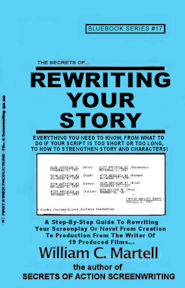
REWRITES Blue Book!
Rewriting In Waves?
When You Finish Your Screenplay Or Novel...
The Rewrites Begin!
The end is just the beginning! You’ve finished your story, but now the rewriting begins! This 405 page book shows you how to rewrite your screenplay or novel to perfection. Everything from Character Consistency to Shoeboxing to How To Give And Receive Notes to 15 Solutions If Your Script’s Too Long! and 15 Solutions If Your Script’s Too Short! to Finding The Cause Of A Story Problem to Good Notes Vs. Bad Notes to Finding Beta Readers to Avoiding Predictability to Learning To Be Objective About Your Work to Script Killer Notes and Notes From Idiots to Production Rewrites and What The Page Colors Mean? and a Complete Rewrite Checklist! The complete book on Rewriting Your Story!
Only $4.99
NEW ISH!
All About Endings!
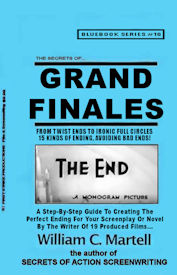
GRAND FINALES Blue Book!
The Perfect Ending For Your Story!
The First Ten Pages Of Your Screenplay Are Critical,
But What About The Last 10 Pages?
Creating the perfect ending to your story! This 100,000 word book shows you how to end your story with a bang, rather than a whimper. Everything from Resolution Order to Act Three Tools to Happy or Sad Endings? to How The Beginning Of Your Story Has Clues To The Ending (in case you were having trouble figuring out how the story should end) to Falling Action to How To Avoid Bad Endings to Writing The Perfect Twist Ending to Setting Up Sequels & Series to Emotional Resolutions to How To Write Post Credit Sequences to Avoiding Deus Ex Machinas, to 20 Different Types Of Ends (and how to write them) and much more! Everything about endings for your screenplay or novel!
Only: $4.99
NO KINDLE REQUIRED! Get the *free* app (any device, except your Mr. Coffee) on the order page on Amazon!
SHRINKING IT DOWN
All About LOGLINES, TREATMENTS, and PITCHING!

LOGLINES, TREATMENTS, and PITCHING! Blue Book!
Distilling Your Screenplay!
Loglines, Treatments, Pitching, Look Books, Pitch Decks, One Pagers, Rip-O-Matics?
You have written a brilliant 110 page screenplay, but how do you get anyone to read it? You need to distill it down into some form of verbal moonshine or story rocket fuel that will ignite that bored development executive or manager or agent and get them to request your screenplay. But how do you shrink those 110 pages into a 25 word logline or a 2 minute elevator pitch or a one page synopsis or a short paragraph? This 100,000 word book shows you how! Everything you need to know! From common logline mistakes (and how to solve them) to how your pitch can reveal story problems to the 4 types of pitches!
272 Pages - ONLY $4.99!
NEW in 2020!
Making Your Own Movie?
WRITE IT: FILM IT BOOK!

Making Your Own Movie?
Writing An Indie Film?
Writing A Low Budget Genre Script To Sell?
Writing A Made For TV Holiday Movie?
You will be writing for BUDGET. On a standard spec screenplay, you don’t have to think about budget, but these types of screenplays writing with budget in mind is critical!
If you are making your own movie, budget, is even more important - and you need to think about budget *before* you write your screenplay... or you will end up with a script that you can’t afford to make (or is a struggle to make). Everyone is making their own films these days, and even if you have done it before there are lots of great techniques in this book to get more money on screen - for less money! You can make a film that looks like it cost millions for pocket change.
344 Pages - ONLY: $7.99!
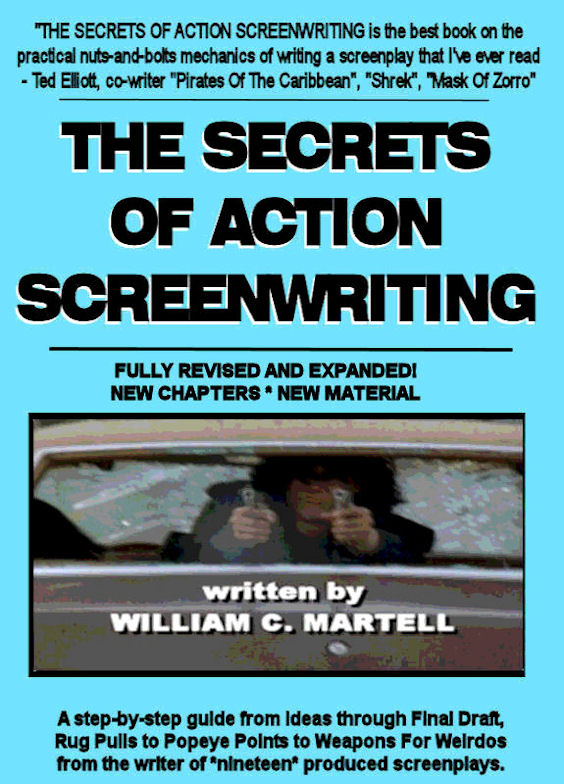
THE BOOK THAT STARTED IT ALL!
*** THE SECRETS OF ACTION SCREENWRITING *** - For Kindle!
*** THE SECRETS OF ACTION SCREENWRITING *** - For Nook!
Why pay $510 for a used version of the 240 page 2000 version that used to retail for $21.95? (check it out!) when
you can get the NEW EXPANDED VERSION - over 500 pages - for just $9.99? New chapters, New examples, New techniques!
"SECRETS OF ACTION SCREENWRITING is the
best book on the practical nuts-and-bolts mechanics of writing a screenplay I've ever read."
- Ted Elliott, co-writer of MASK OF ZORRO, SHREK, PIRATES OF THE CARIBBEAN and the sequels (with Terry Rossio). (ie; 4 of the top 20 Box Office Hits Of ALL TIME.)
Only $9.99 - and no postage!
BRAND NEW!
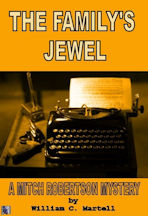
***
MITCH ROBERTSON #2: THE FAMILY'S JEWEL *** - For Kindle!
"The Presidential Suite of the Hollywood Hoover Hotel looked like a bloody battlefield: bodies everywhere, furniture broken, red liquid dripping from the walls, dead soldiers littering the elegant Berber rug as clouds of smoke overhead bounced between two air conditioning vents.
Mitch Robertson stepped over the body of an ex-child star turned sex tape star turned pop star and entered the room, spotted a gun on the floor and picked it up... careful not to spill his coffee with three pumps of mocha syrup from Penny’s Coffee Shop. That coffee was gold, the only thing keeping him going in this dazed state of wakefulness. The gun felt light. Holding it, he saw the silhouette of an 80s action star sitting sideways on a tipped over chair. Motionless. Was he dead? Mitch was still hung over from the Awards Party the night before, and wondered whether this was all some sort of crazy nightmare that he would wake up from... but when he tripped over the brown legs of a bottomless Superhero, flaccid junk encased in a condom but still wearing his mask, and hit the edge of the sofa, gun skittering and coffee spilling, he realized that it was all very real. What the hell had happened here?"
Short Novel. Only 99 cents! - and no postage!
Tips FAQ

My New Script Secrets Newsletter!

THE BLUE BOOKS!
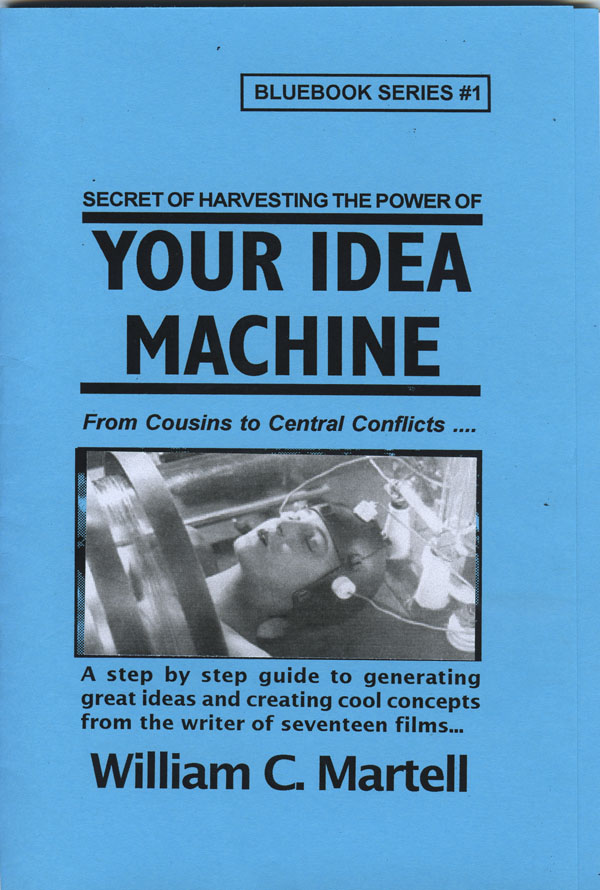
FIND A GREAT IDEA!
*** YOUR IDEA MACHINE *** - For Kindle!
****
Expanded version with more ways to find great ideas! Your screenplay is going to begin with an idea. There are good ideas and bad ideas and commercial ideas and personal ideas. But where do you find ideas in the first place? This handbook explores different methods for finding or generating ideas, and combining those ideas into concepts that sell. The Idea Bank, Fifteen Places To Find Ideas, Good Ideas And Bad Ideas, Ideas From Locations And Elements, Keeping Track Of Your Ideas, Idea Theft - What Can You Do? Weird Ways To Connect Ideas, Combing Ideas To Create Concepts, High Concepts - What Are They? Creating The Killer Concept, Substitution - Lion Tamers & Hitmen, Creating Blockbuster Concepts, Magnification And The Matrix, Conflict Within Concept, Concepts With Visual Conflict, Avoiding Episodic Concepts, much more! Print version is 48 pages, Kindle version is over 175 pages!
Only $4.99 - and no postage!
FIGURE OUT YOUR STORY!
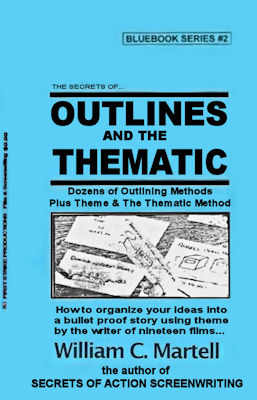
OUTLINES & THE THEMATIC Blue Book.
ARE YOUR SCENES IN THE RIGHT ORDER?
AND ARE THEY THE RIGHT SCENES?
Your story is like a road trip... but where are you going? What's the best route to get there? What are the best sights to see along the way? Just as you plan a vacation instead of just jump in the car and start driving, it's a good idea to plan your story. An artist does sketches before breaking out the oils, so why shouldn't a writer do the same? This Blue Book looks at various outlining methods used by professional screenwriters like Wesley Strick, Paul Schrader, John August, and others... as well as a guest chapter on novel outlines. Plus a whole section on the Thematic Method of generating scenes and characters and other elements that will be part of your outline. The three stages of writing are: Pre-writing, Writing, and Rewriting... this book looks at that first stage and how to use it to improve your screenplays and novels.
Only $4.99 - and no postage!
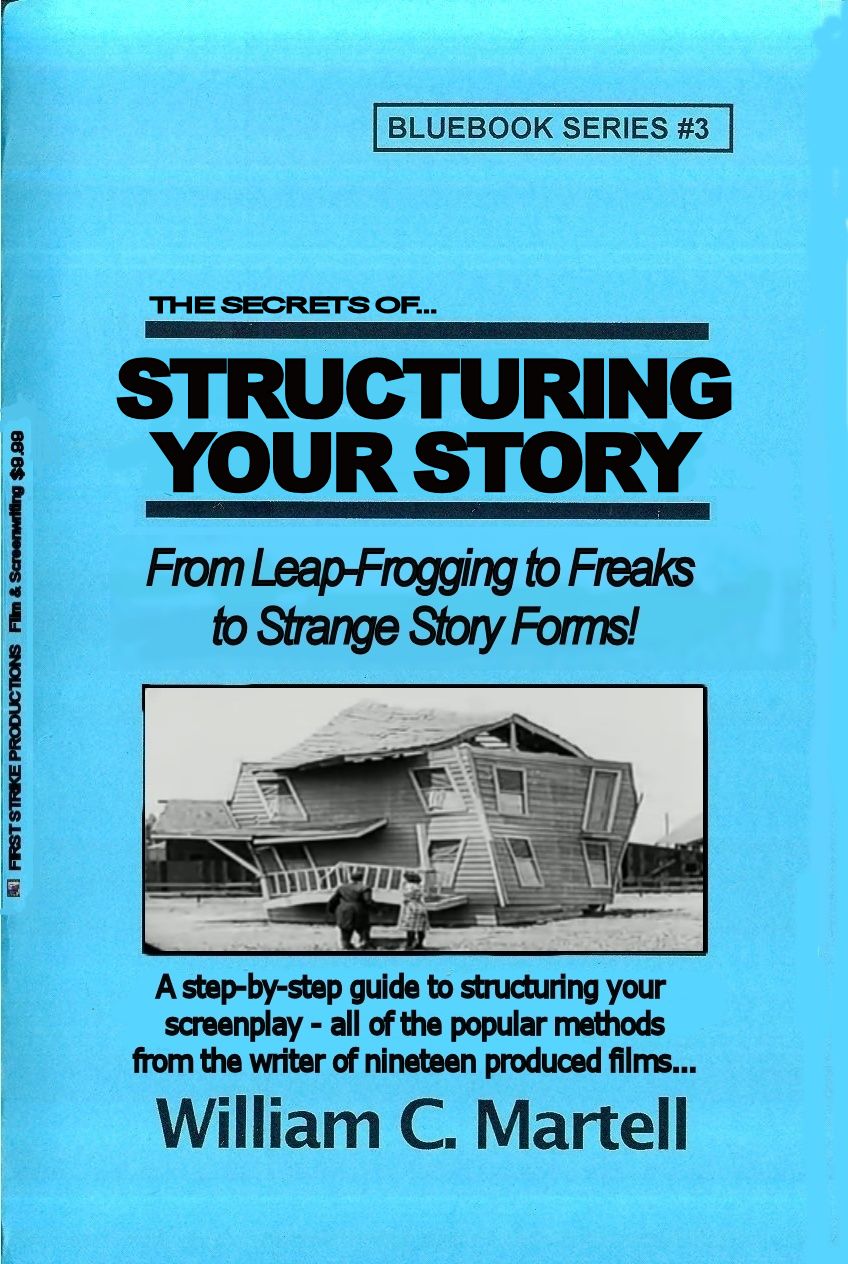
GOT STRUCTURE?!
*** STRUCTURING YOUR STORY *** - For Kindle!
William Goldman says the most important single element of any screenplay is structure. It’s the skeleton under the flesh and blood of your story. Without it, you have a spineless, formless, mess... a slug! How do you make sure your structure is strong enough to support your story? How do you prevent your story from becoming a slug? This Blue Book explores different types of popular structures from the basic three act structure to more obscure methods like leap-frogging. We also look at structure as a verb as well as a noun, and techniques for structuring your story for maximum emotional impact. Most of the other books just look at *structure* and ignore the art of *structuring* your story. Techniques to make your story a page turner... instead of a slug!
Only $4.99 - and no postage!
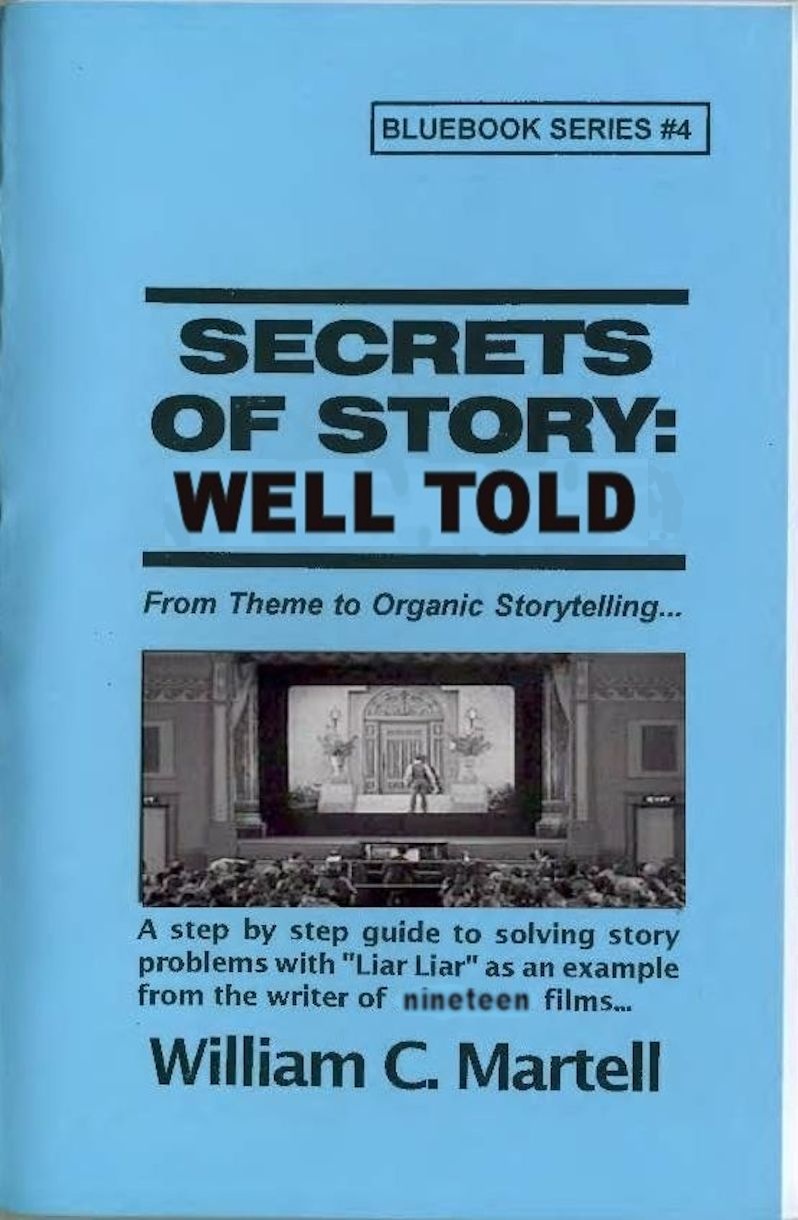
STORY: WELL TOLD!
*** STORY: WELL TOLD *** - For Kindle!
This book takes you step-by-step through the construction of a story... and how to tell a story well, why Story always starts with character... but ISN'T character, Breaking Your Story, Irony, Planting Information, Evolving Story, Leaving No Dramatic Stone Unturned, The Three Greek Unities, The Importance Of Stakes, The Thematic Method, and how to create personal stories with blockbuster potential. Ready to tell a story?
Print version was 48 pages, Kindle version is over 85,000 words - 251 pages!
Only $4.99 - and no postage!

START STRONG!
*** HOOK 'EM IN TEN *** - For Kindle!
Your story doesn't get a second chance to make a great first impression, and this book shows you a
bunch of techniques on how to do that. From the 12 Basic Ways To Begin Your Story, to the 3 Stars Of
Your First Scene (at least one must be present) to World Building, Title Crawls, Backstory, Starting
Late, Teasers and Pre Title Sequences, Establishing Theme & Motifs (using GODFATHER PART 2), Five Critical
Elements, Setting Up The Rest Of The Story (with GODFATHER), and much more! With hundreds of examples
ranging from Oscar winners to classic films like CASABLANCA to some of my produced films (because
I know exactly why I wrote the scripts that way). Biggest Blue Book yet!
Print version was 48 pages, Kindle version is over 100,000 words - 312 pages!
Only $4.99 - and no postage!
NO KINDLE REQUIRED! Get the *free* app (any device, except your Mr. Coffee) on the order page on Amazon!
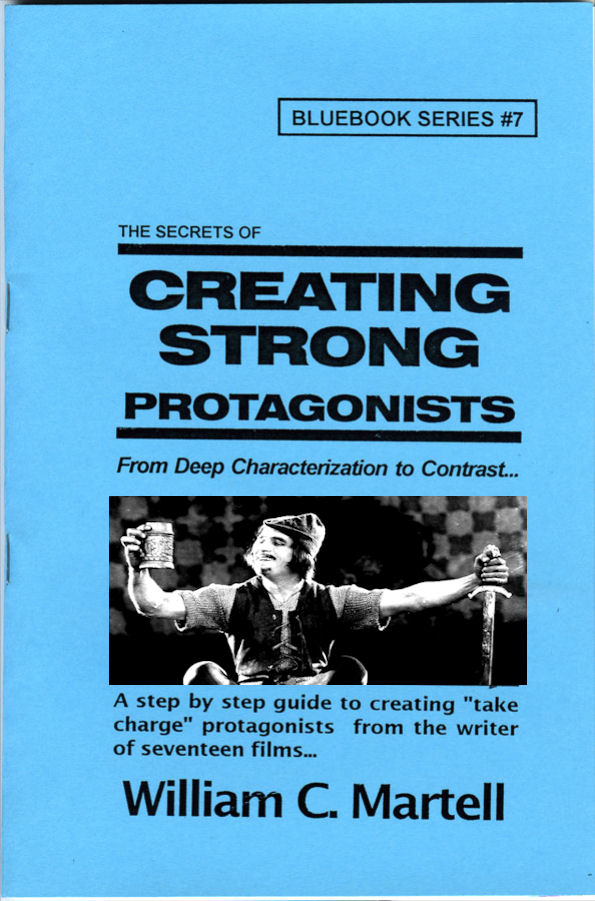
MOVIES ARE CHARACTERS!
*** CREATING STRONG PROTAGONISTS *** - For Kindle!
*** CREATING STRONG PROTAGONISTS *** - For Nook!
Expanded version with more ways to create interesting protagonists! A step-by-step guide to creating "take charge" protagonists. Screenplays are about characters in conflict... characters in emotional turmoil... Strong three dimensional protagonists who can find solutions to their problems in 110 pages. But how do you create characters like this? How do you turn words into flesh and blood? Character issues, Knowing Who Is The Boss, Tapping into YOUR fears, The Naked Character, Pulp Friction, Man With A Plan, Character Arcs, Avoiding Cliche People, Deep Characterization, Problem Protagonists, 12 Ways To Create Likable Protagonists (even if they are criminals), Active vs. Reactive, The Third Dimension In Character, Relationships, Ensemble Scripts, and much, much more. Print version is 48 pages, Kindle version is once again around 205 pages!
ONLY $4.99 - and no postage!
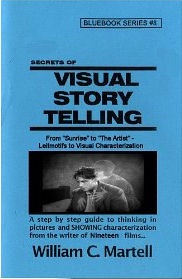
I WRITE PICTURES!
*** VISUAL STORYTELLING *** - For Kindle! (exclusive)
Show Don't Tell - but *how* do you do that? Here are techniques to tell stories visually! Using Oscar Winning Films and Oscar Nominated Films as our primary examples: from the first Best Picture Winner "Sunrise" (1927) to the Oscar Nominated "The Artist" (which takes place in 1927) with stops along the way Pixar's "Up" and Best Original Screenplay Winner "Breaking Away" (a small indie style drama - told visually) as well as "Witness" and other Oscar Winners as examples... plus RISE OF THE PLANET OF THE APES. Print version is 48 pages, Kindle version is over 200 pages!
ONLY $4.99 - and no postage!
DESCRIPTION & VOICE Blue Book!
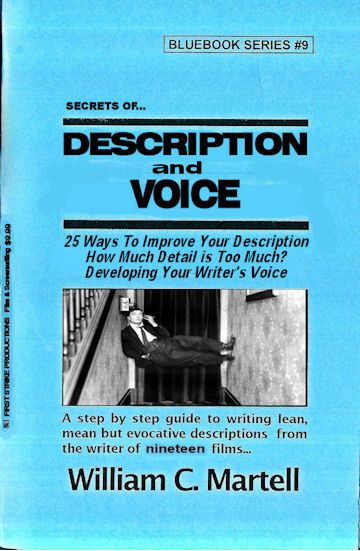
DESCRIPTION & VOICE Blue Book.
IS HALF OF YOUR STORY IN TROUBLE?
Most screenplays are about a 50/50 split between dialogue and description - which means your description is just as important as your dialogue. It just gets less press because the audience never sees it, the same reason why screenwriters get less press than movie stars. But your story will never get to the audience until readers and development executives read your script... so it is a very important factor. Until the movie is made the screenplay is the movie and must be just as exciting as the movie. So how do you make your screenplay exciting to read? Description is important in a novel as well, and the “audience” does read it... how do we write riveting description?
Only $4.99 and no postage!
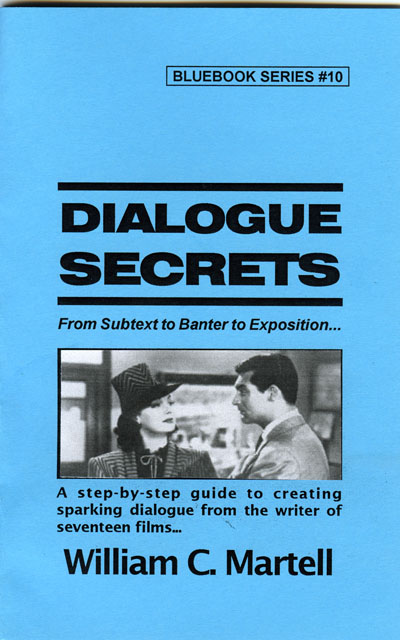
PRO DIALOGUE TECHNIQUES!
*** DIALOGUE SECRETS *** - For Kindle!
***
Expanded version with more ways to create interesting dialogue! How to remove bad dialogue (and what *is* bad dialogue), First Hand Dialogue, Awful Exposition, Realism, 50 Professional Dialogue Techniques you can use *today*, Subtext, Subtitles, Humor, Sizzling Banter, *Anti-Dialogue*, Speeches, and more. Tools you can use to make your dialogue sizzle! Special sections that use dialogue examples from movies as diverse as "Bringing Up Baby", "Psycho", "Double Indemnity", "Notorious", the Oscar nominated "You Can Count On Me", "His Girl Friday", and many more! Print version is 48 pages, Kindle version is over 175 pages!
Only $4.99 - and no postage!

WHAT IS A SCENE?
*** SCENE SECRETS *** - For Kindle!
***
What is a scene and how many you will need? The difference between scenes and sluglines. Put your scenes on trial for their lives! Using "Jaws" we'll look at beats within a scene. Scene DNA. Creating set pieces and high concept scenes. A famous director talks about creating memorable scenes. 12 ways to create new scenes. Creating unexpected scenes. Use dramatic tension to supercharge your scenes. Plants and payoffs in scenes. Plus transitions and buttons and the all important "flow"... and more! Over 65,000 words! Print version was 48 pages, Kindle version is around 210 pages!
Only $4.99 - and no postage!
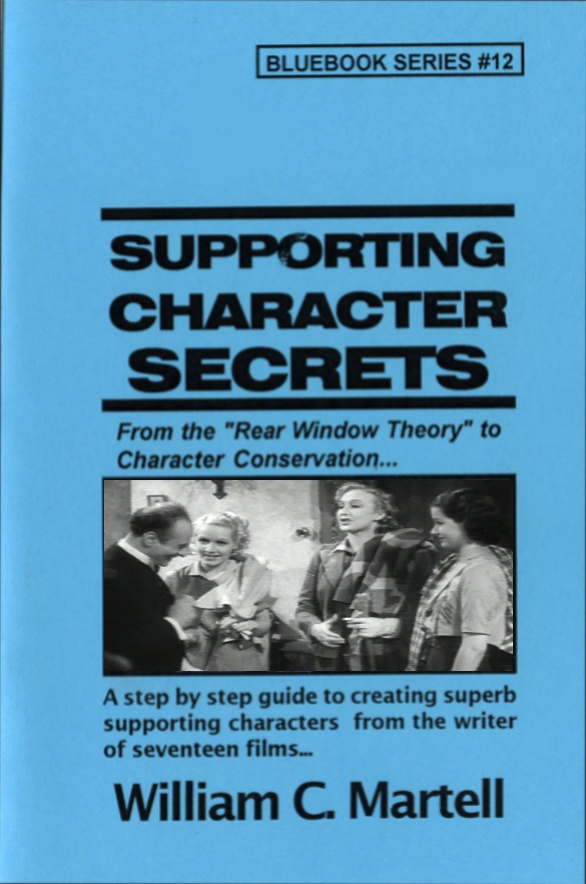
SUBPLOTS?
*** SUPPORTING CHARACTER SECRETS *** - For Kindle! (Exclusive)
Expanded version with more techniques to flesh out your Supporting Characters and make them individuals. Using the hit movie BRIDESMAIDS as well as other comedies like THE HANGOVER and TED and HIGH FIDELITY and
40 YEAR OLD VIRGIN and many other examples we look at ways to make your Supporting Characters come alive on the page.
Print version was 48 pages, Kindle version is around 170 pages!
ONLY $4.99 - and no postage!
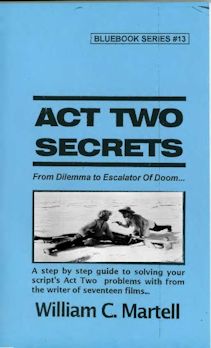
ACT TWO SOLUTIONS!
*** ACT TWO SECRETS *** - For Kindle!
Expanded version with more techniques to help you through the desert of Act Two! Subjects Include: What Is Act Two? Inside Moves, The 2 Ps: Purpose & Pacing, The 4Ds: Dilemma, Denial, Drama and Decision, Momentum, the Two Act Twos, Subplot Prisms, Deadlines, Drive, Levels Of Conflict, Escalation, When Act Two Begins and When Act Two Ends, Scene Order, Bite Sized Pieces, Common Act Two Issues, Plot Devices For Act Two, and dozens of others. Over 67,000 words (that’s well over 200 pages) of tools and techniques to get you through the desert of Act Two alive!
Print version was 48 pages, Kindle version is well over 200 pages!
ONLY $4.99 - and no postage!
READY TO BREAK IN?
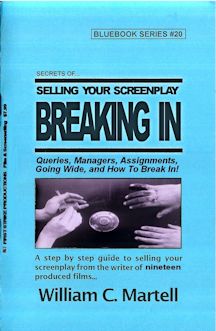
THE BUISINESS SIDE
*** BREAKING IN BLUE BOOK *** - For Kindle!
Should really be called the BUSINESS BLUE BOOK because it covers almost everything you will need to
know for your screenwriting career: from thinking like a producer and learning to speak their language,
to query letters and finding a manager or agent, to making connections (at home and in Hollywood) and
networking, to the different kinds of meetings you are will have at Studios, to the difference between
a producer and a studio, to landing an assignment at that meeting and what is required of you when you
are working under contract, to contracts and options and lawyers and... when to run from a deal!
Information you can use *now* to move your career forward! It's all here in the Biggest Blue Book yet!
Print version was 48 pages, Kindle version is over 400 pages!
$4.99 - and no postage!

STORY IN ACTION SERIES!

THE MISSION IMPOSSIBLE MOVIES
NEW: Updates On Films 7 & 8 Casting!
All Six Movies analyzed! All of the mission tapes, all of the “that’s impossible!” set pieces and stunts, the cons and capers - and how these scenes work, the twists and double crosses, the tension and suspense (and how to generate it), the concept of each film as a stand alone with a different director calling the shots (broken in the sixth film), the gadgets, the masks, the stories, the co-stars and team members (one team member has been in every film), the stunts Tom Cruise actually did (and the ones he didn’t), and so much more! Over 120,000 words of fun info!
THE MISSION IMPOSSIBLE MOVIES - 347 Pages - Only $3.99 !

BRAND NEW!
*** THE BOURNE MOVIES
NEW: Updates on TREADSTONE TV show!
All five "Bourne" movies (including "Legacy" and it's potential sequels) - what are the techniques used to keep the characters and scenes exciting and involving? Reinventing the thriller genre...
or following the "formula"? Five films - each with an interesting experiment! A detailed analysis of each
of the films, the way these thrillers work... as well as a complete list of box office and critical
statistics for each film. This book is great for writers, directors, and just fans of the series.
Only $3.99 - and no postage!
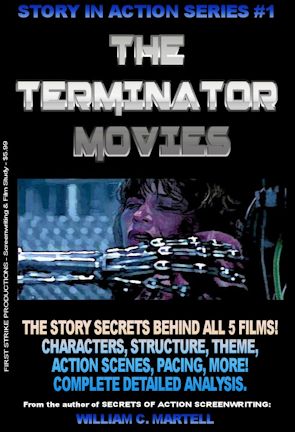
Over 240 pages!
*** THE TERMINATOR MOVIES *** - For Kindle!
He's back! The release of "Terminator: Dark Fate" is set to begin a new trilogy in
the Terminator story... 35 years after the first film was released. What draws us to these films about
a cybernetic organism from the future sent back in time? Why is there a new proposed trilogy every few
years? This book looks at all five Terminator movies from a story standpoint - what makes them work
(or not)? What are the techniques used to keep the characters and scenes exciting and involving? How
about those secret story details you may not have noticed? Containing a detailed analysis of each of
the five films so far, this book delves into the way these stories work... as well as a complete list of
box office and critical statistics for each film. This book is great for writers, directors, and just
fans of the series.
ONLY $3.99 - and no postage!
HITCHCOCK FOR WRITERS!
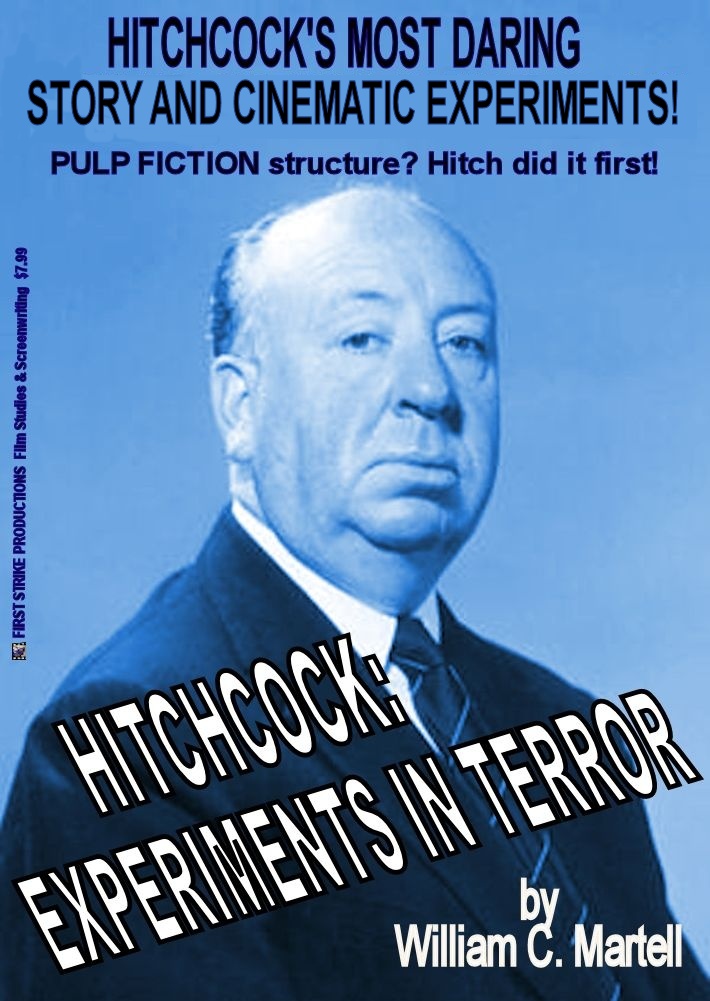
Strange Structures!
*** HITCHCOCK: EXPERIMENTS IN TERROR! *** - For Kindle!
***
Contained Thrillers like "Buried"? Serial Protagonists like "Place Beyond The Pines"? Multiple Connecting Stories like "Pulp Fiction"? Same Story Multiple Times like "Run, Lola, Run"?
HITCHCOCK DID IT FIRST!
This book focuses on 18 of Hitchcock's 52 films with wild cinema and story experiments which paved the way for modern films. Almost one hundred different experiments that you may think are recent cinema or story inventions... but some date back to Hitchcock's *silent* films! We'll examine these experiments and how they work. Great for film makers, screenwriters, film fans, producers and directors.
Only $5.99 - and no postage!
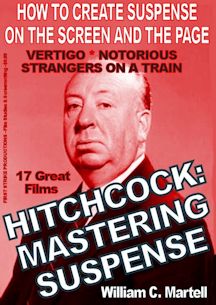
LEARN SUSPENSE FROM THE MASTER!
*** HITCHCOCK: MASTERING SUSPENSE *** - For Kindle!
Alfred Hitchcock, who directed 52 movies, was known as the *Master Of Suspense*; but what exactly is suspense and how can *we* master it? How does suspense work? How can *we* create “Hitchcockian” suspense scenes in our screenplays, novels, stories and films?
This book uses seventeen of Hitchcock’s films to show the difference between suspense and surprise, how to use “focus objects” to create suspense, the 20 iconic suspense scenes and situations, how plot twists work, using secrets for suspense, how to use Dread (the cousin of suspense) in horror stories, and dozens of other amazing storytelling lessons. From classics like “Strangers On A Train” and “The Birds” and “Vertigo” and “To Catch A Thief” to older films from the British period like “The 39 Steps” and “The Man Who Knew Too Much” to his hits from the silent era like “The Lodger” (about Jack The Ripper), we’ll look at all of the techniques to create suspense!
Only $5.99
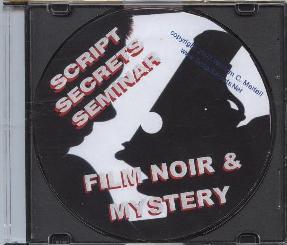
AUDIO CLASS!
NOIR & MYSTERY80 minute MP3 packed with information on writing Film Noir and Mystery scripts. Using examples from CHINATOWN to OUT OF THE PAST to DOUBLE INDEMNITY you'll learn how to create stories in this dark, twisted genre. How to plant clues, red herrings, suspects, victims, spider women, fallen heroes, the funhouse mirror world of noir supporting characters... and the origins of Film Noir in literature Noir dialogue and how noir endings are different than any other genre. All of the critical elements necessary to write in this critically popular genre.
The Noir & Mystery Class is only $15 (plus $5 S&H). First 20 on Limited Black Disk!
PAMDEMIC SALE! $5 OFF!
IDEAS AND CREATIVITY - 80 minute MP3 packed with information. Tools to find ideas that are both personal *and* commercial. Hollywood wants scripts with High Concept stories... but not stupid scripts. Developing *intelligent* high concept ideas. How to turn your personal story into a blockbuster - or find your personal story in a high concept idea. Brainstorming and being creative. Ideas and Creativity is $10.00 (plus $5 S&H)
WRITING INDIES - Writing an Indie film? This class covers everything you need to know - from Central Locations to Confined Cameos. Using examples from SWINGERS, THE COOLER, STATION AGENT and others, this 80 minute MP3 is packed with information. How Indoe films challenge the audience (while mainstream films reassure the audience). Structures, using BOYS DON'T CRY, RUN LOLA RUN, HILARY & JACKIE, and others as example. Writing for a budget, writing for non-actors, getting the most production value out of your budget. Writing Indies is $10.00 (plus $5 S&H)
WRITING HORROR - The essentials of a horror screenplay - what do ROSEMARY'S BABY, NIGHT OF THE LIVING DEAD, THE EXORCIST, BRIDE OF FRANKENSTEIN, THE OTHERS and OPEN WATER have in common? This class will tell you! All of the critical elements necessary to write a script that scares the pants off the audience. Writing Horror is $10.00 (plus $5 S&H).
Click here for more information on CLASS MP3s!

Use your creative energy to focus on the content; let Final Draft take care of the style. Final Draft is the number-one selling application specifically designed for writing movie scripts, television episodics and stage plays. Its ease-of-use and time-saving features have attracted writers for almost two decades positioning Final Draft as the Professional Screenwriters Choice. Final Draft power users include Academy, Emmy and BAFTA award winning writers like Oliver Stone, Tom Hanks, Alan Ball, J.J. Abrams, James Cameron and more.
* * * Buy It!

